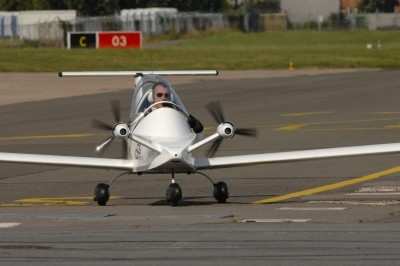Fri, Sep 03, 2010
Four Electric Motors, Lithium Batteries Power Tiny
Airplane
The all electric Cri-Cri, jointly developed by EADS Innovation
Works, Aero Composites Saintonge and the Green Cri-Cri Association,
made its official maiden flight at Le Bourget airport near Paris
Thursday. This Cri-Cri is the first-ever four-engined all-electric
aerobatic plane, which was first shown at the Green Aviation Show
at Le Bourget in June.

Cri-Cri In Flight
The plane became airborne at 1112 CET. Test pilot Didier Esteyne
said take-off and climb were smooth, no vibrations could be felt
and maneuverability was excellent. All systems performed well and
the plane returned safely after 7 minutes. “This aircraft
flies very smoothly, much more quietly than a plane with
conventional propulsion”, said Esteyne. “But we are
still at the beginning and have a lot to learn. We are allowed to
start aerobatic maneuvers only after five hours of flight and 15
landings.”
“The Cri-Cri is a low-cost test bed for system integration
of electrical technologies in support of projects like our hybrid
propulsion concept for helicopters,” stated Jean Botti,
EADS’s Chief Technical Officer. “We hope to get a lot
of useful information out of this project.” In the near
future batteries will be available to propel larger
aircraft.

The aerobatic plane incorporates numerous innovative
technologies such as lightweight composite structures that reduce
the weight of the airframe and compensate for the additional weight
of the batteries, four brushless electric motors with
counter-rotating propellers which deliver propulsion without CO2
emissions and significantly lower noise compared to thermal
propulsion, and high energy-density Lithium batteries. The combined
utilization of these environment-friendly technical innovations
enables the Cri-Cri to deliver 30 minutes of autonomous
cruise flight at about 60 knots, or 15 minutes of autonomous
aerobatics at speeds reaching up to 135 knots, and a climb rate of
approximately 1,000 fpm.
More News
From 2023 (YouTube Version): Legacy of a Titan Robert (Bob) Anderson Hoover was a fighter pilot, test pilot, flight instructor, and air show superstar. More so, Bob Hoover was an i>[...]
Get The Latest in Aviation News NOW on Instagram Are you on Instagram yet? It's been around for a few years, quietly picking up traction mostly thanks to everybody's new obsession >[...]
Aero Linx: B-52H Stratofortress The B-52H Stratofortress is a long-range, heavy bomber that can perform a variety of missions. The bomber is capable of flying at high subsonic spee>[...]
Altimeter Setting The barometric pressure reading used to adjust a pressure altimeter for variations in existing atmospheric pressure or to the standard altimeter setting (29.92).>[...]
"Knowing that we play an active part in bettering people's lives is extremely rewarding. My team and I are very thankful for the opportunity to be here and to help in any way we ca>[...]
 Classic Aero-TV: Remembering Bob Hoover
Classic Aero-TV: Remembering Bob Hoover ANN FAQ: Follow Us On Instagram!
ANN FAQ: Follow Us On Instagram! ANN's Daily Aero-Linx (05.15.24)
ANN's Daily Aero-Linx (05.15.24) ANN's Daily Aero-Term (05.15.24):Altimeter Setting
ANN's Daily Aero-Term (05.15.24):Altimeter Setting Aero-News: Quote of the Day (05.16.24)
Aero-News: Quote of the Day (05.16.24)




